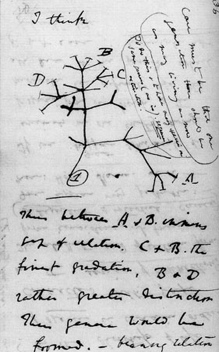Evolution
In biology, evolution is the change in the inherited traits of a population from generation to generation. These traits are the expression of genes that are copied and passed on to offspring during reproduction. Mutations in these genes can produce new or altered traits, resulting in heritable differences (genetic variation) between organisms. New traits can also come from transfer of genes between populations, as in migration, or between species, in horizontal gene transfer. Evolution occurs when these heritable differences become more common or rare in a population, either non-randomly through natural selection or randomly through genetic drift.
Natural selection is a process that causes heritable traits that are helpful for survival and reproduction to become more common, and harmful traits to become rarer. This occurs because organisms with advantageous traits pass on more copies of these traits to the next generation. The measurement of selection on correlated characters (Evolution, volume 37 Over many generations, adaptations occur through a combination of successive, small, random changes in traits, and natural selection of those variants best-suited for their environment.) [1] , Mechanisms: the processes of evolution Understanding Evolution, In contrast, genetic drift produces random changes in the frequency of traits in a population. Genetic drift arises from the element of chance involved in which individuals survive and reproduce.
One definition of a species is a group of organisms that can reproduce with one another and produce fertile offspring. However, when a species is separated into populations that are prevented from interbreeding, mutations, genetic drift, and the selection of novel traits cause the accumulation of differences over generations and the emergence of new species. Stephen Gould, The Structure of Evolutionary Theory, Belknap Press, ISBN 0-674-00613-5 . The similarities between organisms suggest that all known species are descended from a common ancestor (or ancestral gene pool) through this process of gradual divergence. {Douglas J. Futuyma, Evolution, Sinauer Associates, Sunderland, Massachusetts, ISBN 0-87893-187-2 )
The theory of evolution by natural selection was first proposed by Charles Darwin and Alfred Russel Wallace and set out in detail in Darwin's 1859 book On the Origin of Species. On the Origin of Species [2]. Related earlier ideas were acknowledged in http://darwin-online.org.uk/content/frameset?itemID=F381&viewtype=text&pageseq=20] In the 1930s, Darwinian natural selection was combined with Mendelian inheritance to form the modern evolutionary synthesis, "understanding evolution" in which the connection between the units of evolution (genes) and the mechanism of evolution (natural selection) was made. This powerful explanatory and predictive theory has become the central organizing principle of modern biology, providing a unifying explanation for the diversity of life on Earth. [3] Statement on the Teaching of Evolution, The Interacademy Panel on International Issues, [4] Statement on the Teaching of Evolution, American Association for the Advancement of Science.
Heredity
Inheritance in organisms occurs through discrete traits – particular characteristics of an organism. In humans, for example, eye color is an inherited characteristic, which individuals can inherit from one of their parents. (Sturm RA, Frudakis TN, Eye colour: portals into pigmentation genes and ancestry). Inherited traits are controlled by genes and the complete set of genes within an organism's genome is called its genotype. Genetics: what is a gene? (Nature, v. 441, 2006)
The complete set of observable traits that make up the structure and behavior of an organism is called its phenotype. These traits come from the interaction of its genotype with the environment.Template:Cite journal (Epigenetics and phenotypic variation in mammals, Mamm. Genome
External links
General information
- [5] Becoming Human, The Documentary
- Understanding Evolution from University of California, Berkeley
- National Academies Evolution Resources
- Everything you wanted to know about evolution by New Scientist
- Howstuffworks.com — How Evolution Works
- Synthetic Theory Of Evolution: An Introduction to Modern Evolutionary Concepts and Theories
History of evolutionary thought
